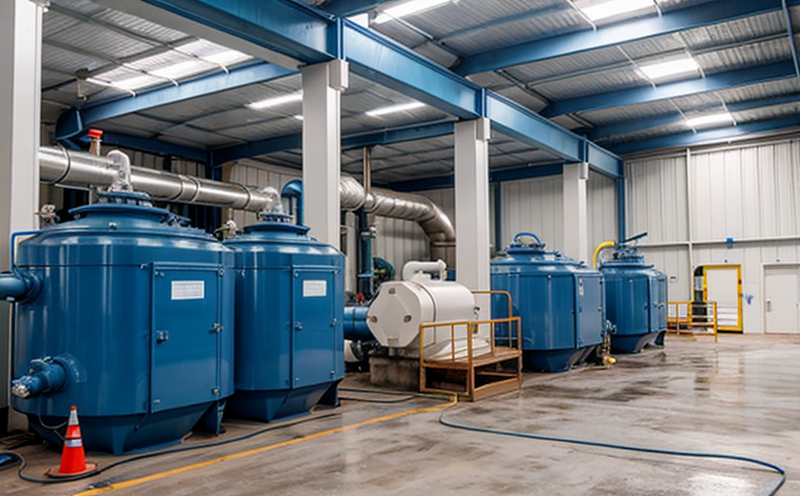ASTM D5908 UV Disinfection Efficiency Testing in Ballast Water
The testing of ballast water using ASTM D5908 is a critical process aimed at ensuring the efficacy of ultraviolet (UV) disinfection systems used to eliminate pathogenic microorganisms, as mandated by international regulations such as the International Maritime Organization's Ballast Water Management Convention. This testing procedure ensures that ballast water treatment systems meet stringent standards for reducing harmful pathogens in ships' ballast tanks.
Ballast water is essential for providing stability and trim to ships during their voyage. However, it can also be a vector for invasive species and pathogenic microorganisms when introduced into new aquatic ecosystems. To mitigate this risk, UV disinfection systems are often employed as part of the ballast water treatment process. ASTM D5908 provides a standardized method to assess the efficiency of these systems in terms of their ability to inactivate pathogens.
The testing involves exposing specific specimens (water samples spiked with indicators or actual pathogens) to UV irradiation under controlled conditions that mimic real-world scenarios on board ships. The efficacy is then measured based on the reduction in viable microbial populations post-exposure. This ensures that the systems are reliable and effective before deployment at sea.
Compliance with ASTM D5908 standards not only meets regulatory requirements but also enhances a company's reputation by demonstrating commitment to environmental sustainability and safety. By adhering to these guidelines, businesses can ensure they are operating within legal boundaries while contributing positively to global maritime practices.
- International Acceptance: ASTM D5908 is widely recognized globally, making it the preferred standard for testing ballast water treatment systems in countries like the United States and the European Union. Compliance with this standard ensures seamless international trade and avoids potential delays or rejections at ports.
Understanding the intricacies of ASTM D5908 UV disinfection efficiency testing requires knowledge of both the technical aspects involved and its broader implications for maritime industries. This includes understanding how different factors such as water quality, flow rate, and system design can affect test outcomes, thus influencing overall performance.
Why It Matters
The importance of ASTM D5908 UV disinfection efficiency testing cannot be overstated given the potential environmental impact of ballast water discharge. Non-indigenous species introduced through ballast water can disrupt local ecosystems, leading to ecological imbalances and economic losses. By ensuring that UV systems meet rigorous testing standards like those specified in ASTM D5908, we contribute significantly towards preserving natural habitats and supporting biodiversity.
Furthermore, compliance with such stringent regulations is crucial for maintaining good standing within the maritime industry. It helps establish trust among stakeholders including governments, shipping companies, and port authorities who rely on accurate data to make informed decisions regarding vessel operations. Adherence to international standards also fosters collaboration between nations working together towards common goals related to sustainable development.
From an economic perspective, investing in robust testing procedures ensures long-term profitability by preventing costly fines or operational disruptions resulting from non-compliance incidents. Additionally, it promotes innovation and advancement within the field of water treatment technology, encouraging manufacturers to develop more efficient and cost-effective solutions for meeting regulatory expectations.
International Acceptance and Recognition
- United States: ASTM D5908 is recognized by agencies such as the U.S. Coast Guard and is a key component of their ballast water management program.
- European Union: The EU has adopted similar standards for ballast water treatment, aligning closely with ASTM D5908 to ensure consistency across member states.
- Australia: Australian authorities use ASTM D5908 as a benchmark for evaluating UV disinfection systems used in the country's shipping industry.
- New Zealand: New Zealand's regulatory framework incorporates ASTM D5908, reflecting its commitment to international best practices.
The widespread adoption of ASTM D5908 underscores its significance as a globally accepted standard for UV disinfection efficiency testing in ballast water. Its implementation ensures harmonization of standards across jurisdictions, facilitating smoother operations and reducing barriers to trade between countries.
Competitive Advantage and Market Impact
Adopting ASTM D5908 UV disinfection efficiency testing offers numerous strategic benefits that can give businesses a competitive edge in the market:
- Regulatory Compliance: Ensures strict adherence to international regulations, thereby avoiding penalties associated with non-compliance.
- Innovation: Encourages continuous improvement of UV disinfection technologies, leading to more advanced and effective systems.
- Reputation: Builds trust among clients and stakeholders by demonstrating a commitment to environmental responsibility and safety.
- Cost Efficiency: Identifies any inefficiencies early on through rigorous testing, allowing for timely adjustments that save money in the long run.
In today’s competitive landscape, companies that prioritize sustainability and quality are gaining an edge over their competitors. By integrating ASTM D5908 UV disinfection efficiency testing into their operations, businesses can position themselves as industry leaders, attracting more customers and partners while maintaining high standards of environmental stewardship.





